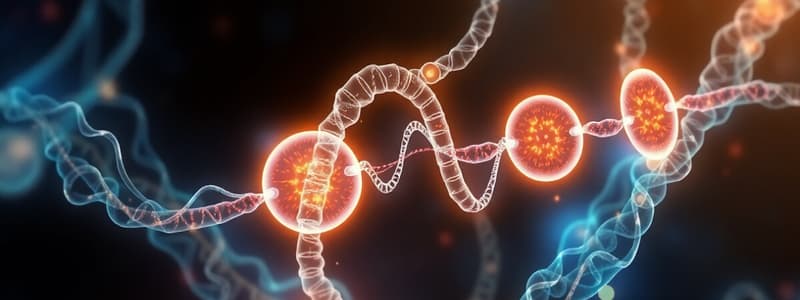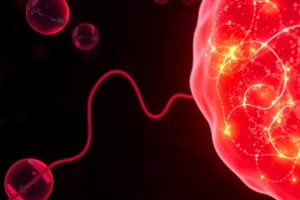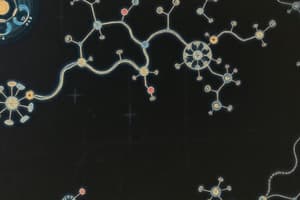Podcast
Questions and Answers
What is the net ATP gain from glycolysis for each glucose molecule broken down?
What is the net ATP gain from glycolysis for each glucose molecule broken down?
- 15 ATP
- 2 ATP (correct)
- 30-32 ATP
- 4 ATP
What happens to pyruvate molecules after glycolysis under aerobic conditions?
What happens to pyruvate molecules after glycolysis under aerobic conditions?
- They are directly used in the cytoplasm for protein synthesis.
- They are excreted from the cell as waste.
- They are converted back into glucose.
- They are converted to acetyl-CoA and processed by mitochondria. (correct)
Besides energy production, what other role can glucose play inside a cell?
Besides energy production, what other role can glucose play inside a cell?
- It can be converted into structural materials like glycoproteins and nucleic acids. (correct)
- It is broken down into fatty acids.
- It can only be used for immediate energy production.
- It is directly converted into amino acids.
How many molecules of $CO_2$ are generated when a pair of pyruvate molecules is catabolized in the mitochondria?
How many molecules of $CO_2$ are generated when a pair of pyruvate molecules is catabolized in the mitochondria?
If a cell processes one molecule of glucose, how many molecules of pyruvate are produced?
If a cell processes one molecule of glucose, how many molecules of pyruvate are produced?
How many ATP molecules are gained when one molecule of pyruvate is processed by the mitochondria?
How many ATP molecules are gained when one molecule of pyruvate is processed by the mitochondria?
What is the primary function of glycolysis in a cell?
What is the primary function of glycolysis in a cell?
What is the total number of water molecules produced when one molecule of glucose is fully processed (glycolysis + mitochondrial processing of pyruvate)?
What is the total number of water molecules produced when one molecule of glucose is fully processed (glycolysis + mitochondrial processing of pyruvate)?
In the context of cellular energy production, what conversion directly precedes the processing of pyruvate by mitochondria?
In the context of cellular energy production, what conversion directly precedes the processing of pyruvate by mitochondria?
What is the importance of converting glucose to glycerol within the cell?
What is the importance of converting glucose to glycerol within the cell?
How does the cell utilize the ribose that can be derived from glucose?
How does the cell utilize the ribose that can be derived from glucose?
What is the net ATP production from glycolysis, and what happens to the end product if oxygen is available?
What is the net ATP production from glycolysis, and what happens to the end product if oxygen is available?
If a cell requires a large amount of ATP quickly, which pathway will it primarily rely on?
If a cell requires a large amount of ATP quickly, which pathway will it primarily rely on?
What is the primary input for the mitochondrial processes that follow glycolysis?
What is the primary input for the mitochondrial processes that follow glycolysis?
Which of the following processes is anaerobic?
Which of the following processes is anaerobic?
For each molecule of pyruvate processed by mitochondria, how many molecules of $O_2$ are consumed?
For each molecule of pyruvate processed by mitochondria, how many molecules of $O_2$ are consumed?
What is the consequence of a cell being unable to convert pyruvate into acetyl-CoA?
What is the consequence of a cell being unable to convert pyruvate into acetyl-CoA?
Assuming oxygen is readily available, which process yields the most ATP per glucose molecule?
Assuming oxygen is readily available, which process yields the most ATP per glucose molecule?
After glycolysis, what is the next major step required for the extraction of energy from a glucose molecule?
After glycolysis, what is the next major step required for the extraction of energy from a glucose molecule?
When two molecules of pyruvate are fully catabolized by the mitochondria, how many ATP molecules are produced?
When two molecules of pyruvate are fully catabolized by the mitochondria, how many ATP molecules are produced?
Flashcards
Ribose
Ribose
A simple sugar that glucose can be converted into for building glycoproteins, structural materials, or nucleic acids.
Glycolysis
Glycolysis
The anaerobic process where a 6-carbon glucose molecule is broken down into two 3-carbon molecules of pyruvate, yielding a net gain of 2 ATP.
Pyruvate
Pyruvate
A 3-carbon molecule that is the product of glycolysis and can be used by mitochondria after conversion to acetyl-CoA.
Acetyl-CoA
Acetyl-CoA
Signup and view all the flashcards
ATP Gain per Pyruvate
ATP Gain per Pyruvate
Signup and view all the flashcards
Study Notes
- Inside cells, glucose can transform into ribose, which is a simple sugar used in building glycoproteins, structural materials, or nucleic acids.
- Glucose can also convert to glycerol, which is essential for synthesizing glycerides.
- When energy is needed, glucose is broken down into two pyruvate molecules via glycolysis.
- Glycolysis is an anaerobic process.
- Glycolysis results in a net gain of 2 ATP for each glucose molecule processed.
- Each pyruvate molecule is converted into acetyl-CoA.
- Mitochondria then use acetyl-CoA.
- The processing of each pyruvate molecule by mitochondria yields 15 ATP.
- For each molecule of pyruvate processed, 3 molecules of oxygen (O2) are consumed.
- The mitochondrial process generates 3 molecules of carbon dioxide (CO2) and 6 molecules of water per pyruvate molecule.
- Catabolizing a pair of pyruvate molecules yields 30–32 ATP for the cell.
Studying That Suits You
Use AI to generate personalized quizzes and flashcards to suit your learning preferences.




